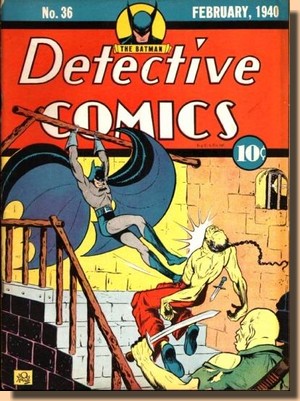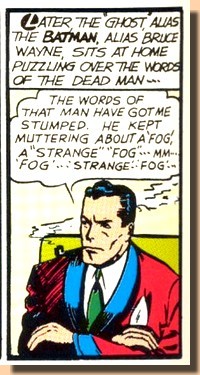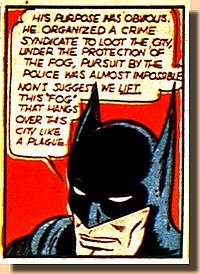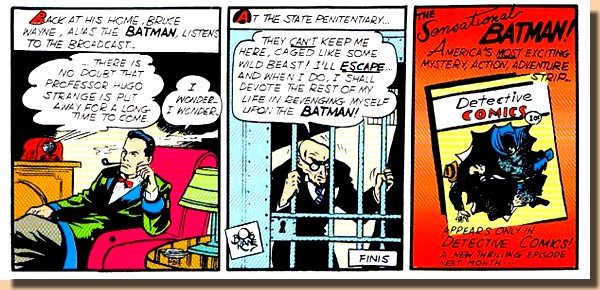|
 |
|
SPOTLIGHT
ON
DETECTIVE COMICS
#36
FEBRUARY 1940
originally untitled
(12 pages)
Story - Bill Finger
Art - Bob Kane (signed), Jerry
Robinson (backgrounds)
Inks - Bob Kane (signed)
Lettering - Jerry Robinson
Editor - Vincent Sullivan
Cover - Bob Kane
(signed)
|
|
| |
PLOT SUMMARY
"ALREADY
AN ALMOST LEGENDARY FIGURE,
THE COWLED SHADOW OF THE BATMAN PROWLS THROUGH
THE NIGHT,
PREYING UPON THE CRIMINAL PARASITE,
LIKE THE WINGED CREATURE WHOSE NAME HE HAD ADOPTED"
|
| |
| Whilst
out on a routine patrol, the Batman witnesses a
man being shot from a moving car. Discovering
that the victim is in fact an FBI agent he also
hears his last words - "strange...
fog" - before having to hurriedly leave
the scene as the police arrive and assume that
the Batman is responsible for the killing. Back at Wayne Manor, Bruce
concludes that the G-Man was not talking of a strange
fog but rather meant a fog connected to a person named
Strange - Professor Hugo Strange, "the
most dangerous man in the world! Scientist,
philosopher, and a criminal genius..."
Elsewhere, it is
indeed Professor Hugo Strange who is mysteriously
blanketing the city in a thick fog to cover the
robberies of his men and preventing the police
form from pursuing them. But Bruce Wayne quickly
adds up the pieces of information he has got - a
list of banks (some already robbed) from the dead
agent, and the reported kidnapping of a prominent
electrical engineer - and heads into action as
the Batman. Although initially walking straight
into a trap set by Strange, the Darknight
Detective quickly turns the tables and brings
down both Hugo Strange and his hoodlums.
Searching the mad scientist's hideout, the Batman
discovers both a giant machine powering the
artificial fog and the kidnapped scientist who
was forced to build it for Strange.
|
|

|
|
| |
| The Batman is
praised by the media, and Hugo Strange is
imprisoned at the State Penitentiary - vowing
escape and revenge. |
|
| |
REVIEW
& ANALYSIS
In his tenth
appearance in Detective Comics, the
Batman encounters the first villain who would -
albeit not immediately - become a recurring
fixture in the Darknight Detective's rogues
gallery: Professor Hugo Strange (who would return twice
during the Golden Age, then be forgotten, but
eventually be brought back with a bang for the
Bronze Age and from then on appear repeatedly).
|
|
| |
 |
|
Detective
Comics #36 also introduces Jerry Robinson to
the Batman who - inking Bob Kane's pencils and
drawing the backgrounds - instantly provided
added value to the artwork which immediately
comes across as far more dynamic than in previous
issues. On an
overall plot and storytelling level, Detective
Comics #36 compares favourably with some of
its preceding 1939 issues, as Bill Finger
actually does a decent job of telling a story
which develops in a fairly linear fashion.
Events move along
without any excessive jumps or even black holes
of logic, and most of the time what happens is
motivated by coherent objectives of the acting
individuals - such as Professor Hugo Strange
devising and enacting a device which will aid him
in his bank robberies and at the same time help
him set up the largest crime syndicate in town.
|
|
| |
| Nevertheless,
Golden Age comics from the 1940s are a matter of
taste, and even Detective Comics #36
highlights some of the problems inherent in most
comic books from that era which can make them
such a hard read today. Although Finger avoids the
major and often ludicrous showstoppers seen in
previous issues of Detective Comics (where
logic and coherence are sometimes ignored
outright), his story still has more than its fair
share of "you must be kidding" moments.
First off, when Batman witnesses a man being
shot, he finds out that the victim is in fact a
G-Man when he flips through the dead man's black
notebook and finds a note on the bottom of a page
which reads "if this book is found
please notify the FBI". Next, Bruce
Wayne's conclusion that the agent's dying words "strange...
fog" must link up to Professor Hugo
Strange, of whom "little is known",
is conjured up completely out of thin air. And as
a man of genius and cunning, Strange commands
teams of robbers who, quite unlike the city
police force, can drive around in thick fog as
though the sun were shining ... In other words:
even this above average story contains its fair
share of bumps and loopholes which, unless you
are eight to ten years old, can at times be hard
to swallow - similar to some of the terminology
used, which amongst other things labels criminals
across the board as "parasites".
Clearly, these were different days in many
respects.
|
|
| |
| However, the
introduction of Professor Hugo Strange is
handled well, and although the
characterization follows the "mad
scientist with an Austro-German
background" stereotype virtually by
the book - with his German first name,
bald head and goatee he almost looks like
a twin brother of Dr Karl Helfern a.k.a. Doctor
Death from Detective
Comics #29
(July 1939), the only major difference
being that Strange wears thick glasses
whereas Helfern used a monocle. |
|
 |
|
|
| |
| However, Professor
Hugo Strange worked better than Doctor Death
because Finger had given him an overall original
plan he wanted to achieve (to become the city's
number one mobster) which, when foiled by the
Darknight Detective, changes into now just
wanting to seek revenge upon the Batman - and he
thus became an important early part of the Batman
legacy. One
important point which sets Detective Comics #36
apart from its preceding issues is the artwork,
which thanks to Jerry Robinson's inks and
backgrounds has immediately gained dimension and
a somewhat more dynamic character. The issue,
however, still remains accidental reading matter
even for Batman afficionados - it is distinctly
more entertaining than average 1940s Batman
stories but truly interesting only for its
introduction of Professor Hugo Strange.
|
|
FACTS
& FIGURES
Apart from the first
appearance of Professor Hugo Strange,
Batman’s finned gloves are also seen for the
first time. Not the first time, however, DC got
the cover wrong as the events depicted are
clearly tied in to the Batman story featured in Detective
Comics #35 in which the Darknight Detective
battles a certain Sin Fang who has stolen a ruby
idol.
The location of
events still remains, at this point, unnamed -
Batman's hometown would not be identified as
Gotham City until Batman #4 (Winter 1940).
The Batman story of
course was the lead attraction of Detective
Comics #36, but as was standard procedure
for a 1940s comic book, Detective Comics featured
several additional characters in its total of 68
pages -in this case Bart Regan, Spy (6 pages),
Buck Marshall, Range Detective (6 pgs), Steve
Malone, District Attorney (6 pgs), Speed
Saunders, Ace Investigator (6 pgs), Cosmo,
Phantom of Disguise (6 pgs), Bruce Nelson (6
pgs), and Slam Bradley (10 pgs).
This story has been
reprinted in Batman Archives vol
1 (1990) and Batman Chronicles #1
(2005).
|
|
| |
|
| |
BATMAN and all
related elements are the property of DC
Comics, Inc. TM and © DC Comics, Inc., a
subsidiary of Time Warner Inc.
The illustrations presented here are
copyright material. Their reproduction for
the review and research purposes of this
website is considered fair use as set out by
the Copyright Act of 1976, 17
U.S.C. par. 107.

text is copyright 2014 by atw
first published
on the web 21 December 2014

|
|